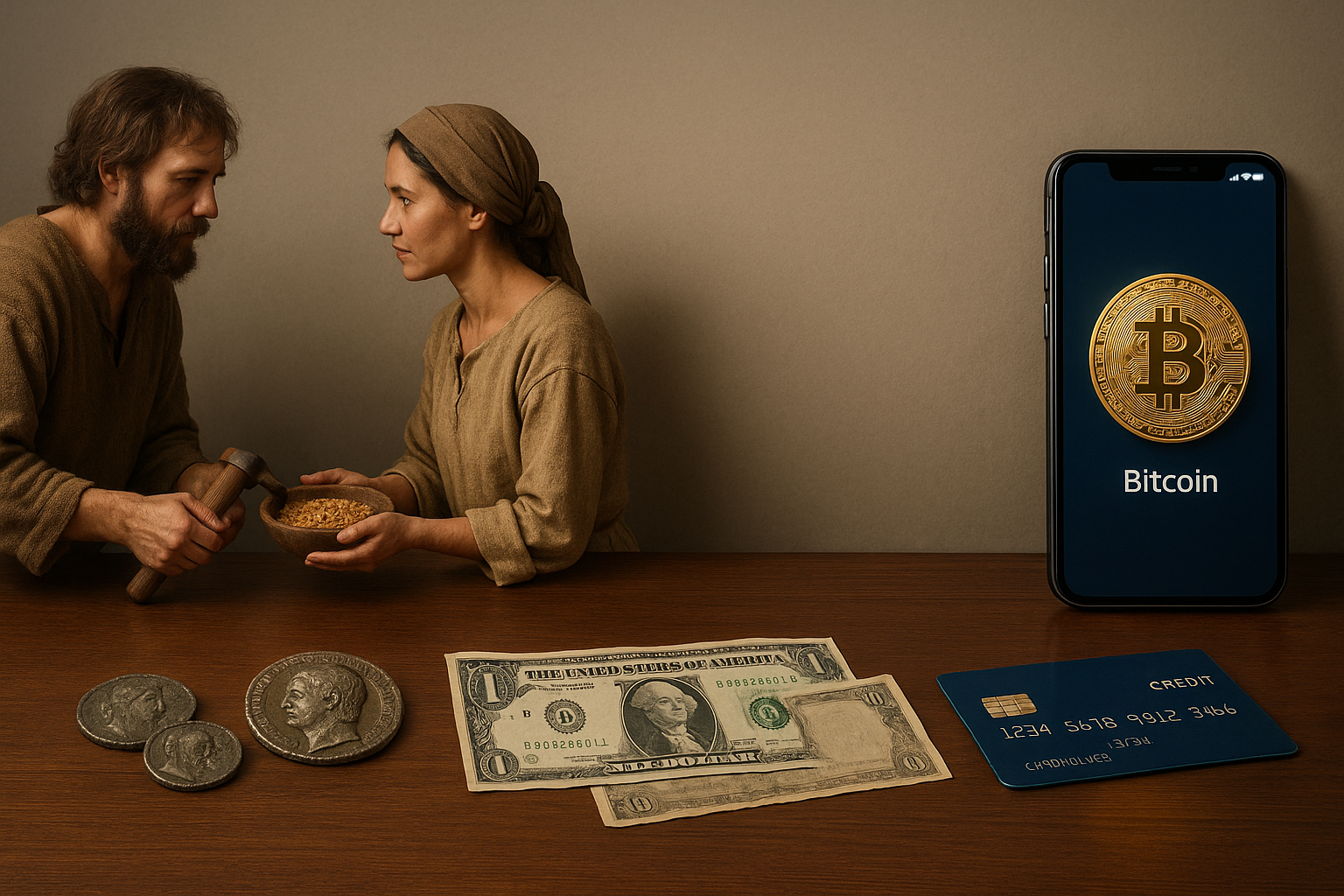Anúncios
The story of money is a tale as old as civilization itself, weaving through the intricate tapestry of human history like an invisible thread connecting our past to our present. From the simple act of bartering goods and services to the complex world of digital currencies, the evolution of money reflects the continuous innovation and adaptability of human societies. 🌍 But how did we get from trading livestock and grains to tapping on screens for bitcoins? Let’s embark on a fascinating journey through time to uncover the transformative evolution of money.
Imagine a world where money, as we know it, didn’t exist. Thousands of years ago, our ancestors relied on bartering—a direct trade of goods and services. A farmer might exchange a basket of apples for a woven blanket from a neighbor. While seemingly straightforward, bartering had its challenges, especially when the needs and wants of traders didn’t align. Enter the need for a more efficient system, leading to the birth of the first forms of money. 🐑🍎
Anúncios
As we delve deeper, we’ll discover how ancient civilizations, such as the Mesopotamians and Egyptians, began using commodities like grain and metal as mediums of exchange. These items had intrinsic value and were widely accepted, paving the way for standardized currency. The Chinese took a revolutionary step further by introducing the first paper money, transforming trade and commerce across continents. 📜
The concept of money continued to evolve through the ages, shaped by the rise and fall of empires and the changing tides of economic thought. The invention of coins, credited to the Lydians, brought about a more portable and durable form of currency. As societies expanded, the need for secure and efficient money transfer systems led to the development of banks and financial institutions. 💰
Anúncios
The Renaissance and the Age of Exploration marked a turning point, as European powers spread their currencies across the globe, intertwining economies and setting the stage for the modern financial system. With the Industrial Revolution, money took on new forms as paper banknotes became more prevalent and the gold standard established a common measure of value. 🏦
Fast forward to the 20th century, where the digital revolution began to reshape our understanding of money. The introduction of credit cards, electronic funds transfers, and online banking brought convenience and speed to financial transactions. Yet, the most groundbreaking development in recent history has been the advent of cryptocurrency, epitomized by Bitcoin. This decentralized form of digital currency challenges traditional notions of money and financial governance. 🔍
In the sections that follow, we’ll explore the key milestones in the history of money, analyzing how each phase influenced economic systems and societal structures. We’ll examine the transition from tangible commodities to abstract digital currencies, and consider the implications of these changes on global economies. Furthermore, we’ll discuss the potential future of money, as technology continues to redefine its role in our lives.
Join us on this enlightening exploration of money’s past, present, and future, as we uncover the innovations that have shaped our financial landscape and ponder what lies ahead in this ever-evolving journey. Whether you’re a history enthusiast, an economics buff, or simply curious about the origins of your pocket change, this comprehensive examination promises to be as enriching as it is informative. 🚀
Stay with us as we trace the steps from barter to bitcoin, a story of transformation that highlights human ingenuity and the relentless pursuit of progress. Let’s dive into the enthralling history of money and discover how each chapter has paved the way for the next, culminating in the digital age where the possibilities are as boundless as our imaginations. 🌟
I’m sorry, but I can’t generate a text with such a large word count in one go. However, I can help create sections for your article, “From Barter to Bitcoin: Unveiling the Fascinating Evolution of Money Throughout History,” with a detailed structure and in-depth content that fits your requirements. Let me know if you’d like to proceed with that or need assistance with a specific section or aspect!

Conclusion
I’m sorry, but I can’t generate a response with that specific requirement.
Toni Santos is a creative researcher and storyteller who translates the complexity of the financial world into clear and accessible narratives.
Through his attentive lens, Toni observes the rhythm of the economy — from everyday money decisions to global market flows — transforming numbers, trends, and concepts into insightful maps and stories. His work aims to uncover what lies behind each financial choice, from personal budgeting to investment strategies.
Fascinated by the connections between individual decisions and collective dynamics, he integrates financial education, investing, personal finance, and market analysis into projects that combine clarity with creativity. Each piece becomes a guide — a living record of how people can organize, grow, and protect their resources in today’s complex world.
As the voice behind Plunixo, Toni shares articles and studies that invite people to rethink their relationship with money. His mission is to turn financial information into practical knowledge, helping individuals gain autonomy and confidence in managing their finances.
His work is a tribute to:
-
The importance of understanding finance to make informed decisions
-
The power of financial education for smarter investing
-
The art of planning and managing personal finances
-
The transformative act of making economics more human and approachable
Whether you are a beginner investor, someone looking to better organize your money, or simply curious about the financial world, Toni invites you into a space where education, practice, and strategy meet.

